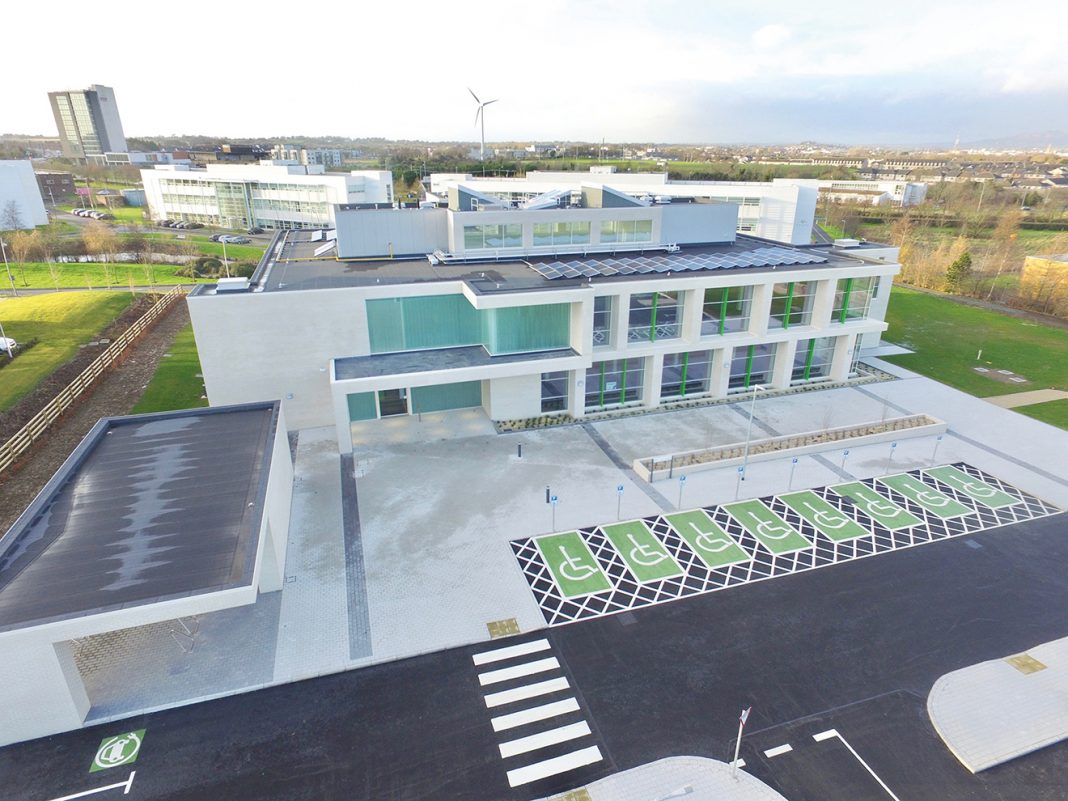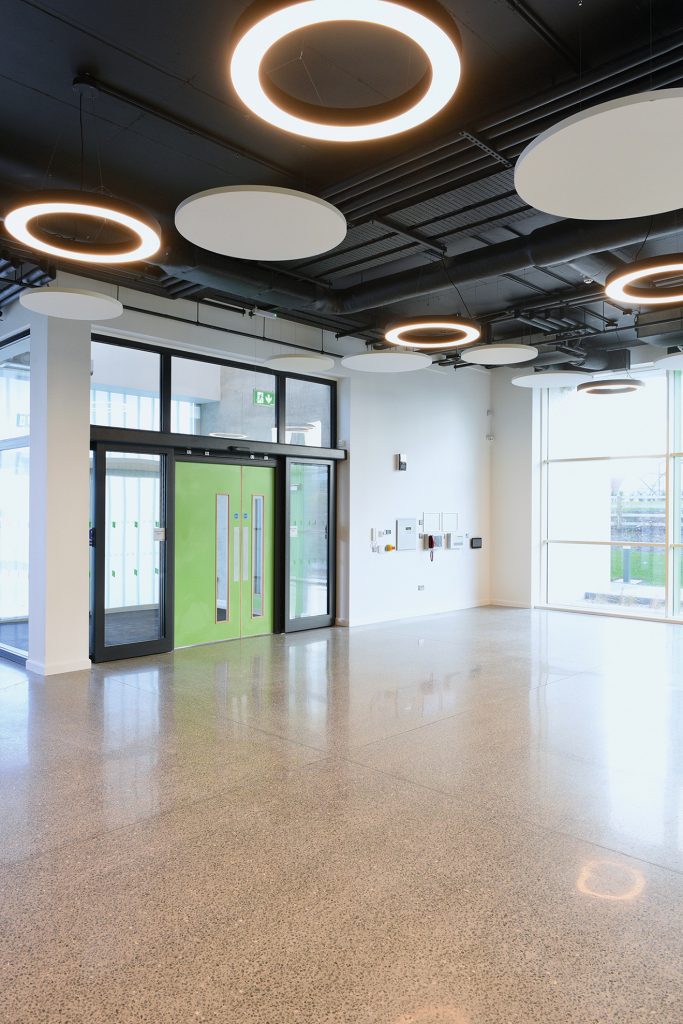The figures make for impressive reading. The new Industrial Development Authority (IDA) Ireland Advance Office Building is a facility just shy of 33,000 square feet, sat on a site encompassing 4.2 acres, and within the Sustainable Energy Zone, hub of Dundalk’s 2020 initiative spearheaded by the Sustainable Energy Authority of Ireland (SEAI).
Aimed at providing high quality office accommodation to IDA clients, it is also part of the SEAI game-plan of stimulating a move towards sustainable energy practice, an ethos incorporated in the building itself. With plans for the €7m build only announced in April 2016, the challenge facing main contractor Felix O’Hare & Co Ltd was transforming a greenfield site into a state-of-the-art office space in what amounted to a relatively short time frame (work started July 16, 2018).
First established in 1944 and now an industry leader, it was a challenge the award-winning Newry-based company readily accepted. First up was excavation of the site at the Finnabair Industrial Park, off Dundalk’s Inner Relief Road, then pad and strip foundations, and on to a two- storey fully-reinforced concrete frame and in-situ concrete floors.
The impressive main reception on the ground floor is replicated on the first floor, with a feature steel frame atrium. This double-height glazed entrance enhances natural light and reduces artificial light dependency.
Designed to accommodate four separate clients, the first of two floor-plates measures 16,921 square feet, the first floor a further 15,898 square feet, both wrapping around that central atrium. The building also houses two 8-person lifts and three perimeter reinforced concrete stairs with risers and services.
The roof features 166×50 kVA PV (Photovoltaic) panels that convert sunlight into electricity, fire-rated AOV roof lights, and plant rooms – complete with a walkway that takes you over a large attenuation tank.
Work on the building’s façade required substantial scaffolding, and features brick curtain walling, Kingspan louvred panels, and Profilit feature glass walls. The deep reveals were one of the more challenging design ideas to bring to fruition for van Dijk Architects Ltd, but provide one of the building’s distinctive features. The interior is a shell and core base build with raised access flooring and full ceiling tiles. A blank canvas for prospective tenants capable of supporting 100% expansion (subject to planning permission) the concrete floors have also been mechanically ground, honed, and polished. Add into the mix a ventilation system, meeting, communications, and data rooms, plus shower and toilet facilities. The exterior works include the creation of a new entrance for vehicles to serve the entire facility, 145 car park spaces, 52 for bicycles, and appropriate landscaping with hedge and tree screen planting to the site boundaries.
Over the past seven decades IDA Ireland has evolved into a key influencer in the development of the Irish economy, attracting invaluable Foreign Direct Investment (FDI). This new high- spec, purpose-built facility looks set to carry on that good work and provide an economic boost to the north east. Felix O’Hare & Co Ltd has more than played its part.
Felix O’Hare & Co Ltd, 88 Chancellors Road, Newry BT35 8NG, County Down
T: +44 (0)28 30261134
E: admin@felixohare.co.uk
W: www.felixohare.co.uk
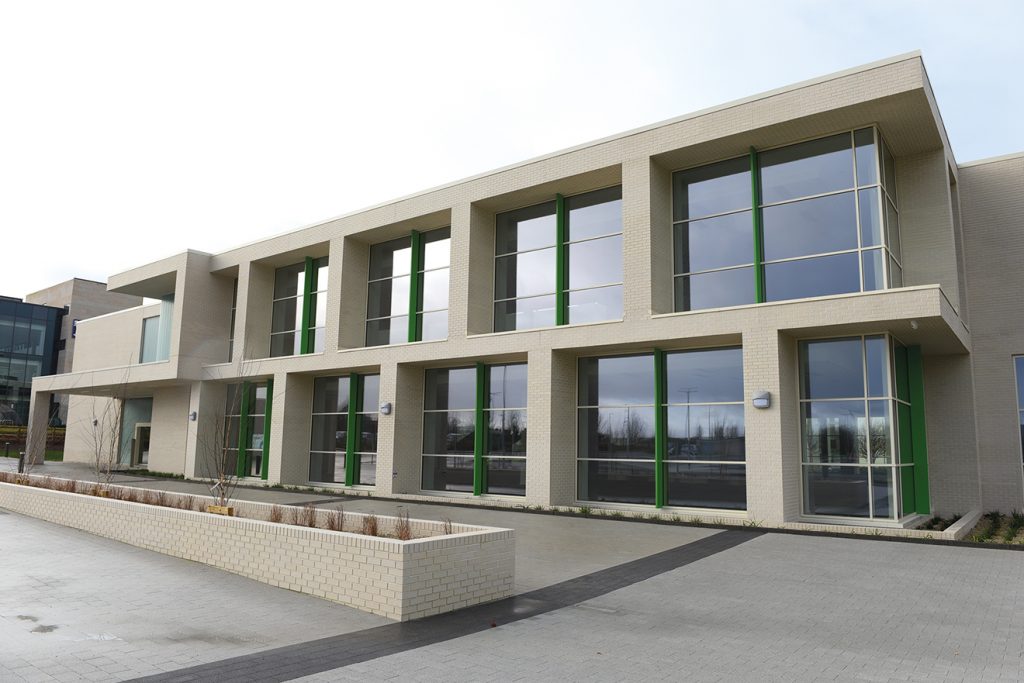
One of the key features of the new IDA Advance Office Building in Dundalk is the welcome preponderance of natural light. For the office staff who will occupy this impressive space, it is certain to be viewed as one of the perks of the job.
The job of realising the architect’s vision in this regard fell to window and door specialists McMullanO’Donnell, from County Tyrone. The company utilised the APA TB50 façade system, complimentary ST80 rebate doors, and triple glazing in order to achieve the required extreme performance U Value (window thermal transmittance).
“All the glazing was heat soaked in order to reduce the risk of nickel sulphide (NiS) inclusions in the glass,” explained Michael McMullan. “Ultimately, that enhances the performance of the glazing and reduces risk from spontaneous breakages, a challenge for toughened glass in today’s world.”
Although the APA façade system can achieve large spans and accommodate a variety of glazing specifications, McMullanO’Donnell did have to create a bespoke external cover cap solution within the system in order to meet the architect’s special design requirements. That collaboration, the ability to craft materials to meet a client’s needs, is a feature of such builds, and one of the keys to their success.
“We have a really good working relationship with architects like Van Dijk International and the main contractor at the IDA build in Dundalk Felix O’Hare & Co Ltd. As specialists in the design, manufacture, and installation of high performance architectural systems, McMullanO’Donnell has been fortunate to work on a diverse range of projects, from Dublin Airport to Down Leisure Centre, St Patrick’s Academy, Dungannon, to Craigavon Area Hospital. We are delighted to add the IDA Advance Office Building in Dundalk to our portfolio.”
McMullanO’Donnell. Benburb Head Office. 101, Drumflugh Road, Benburb BT71 7LF.
T: +44 (0)28 3754 8791
E: info@mcmullanodonnell.com
W: www.mcmullanodonnell.com
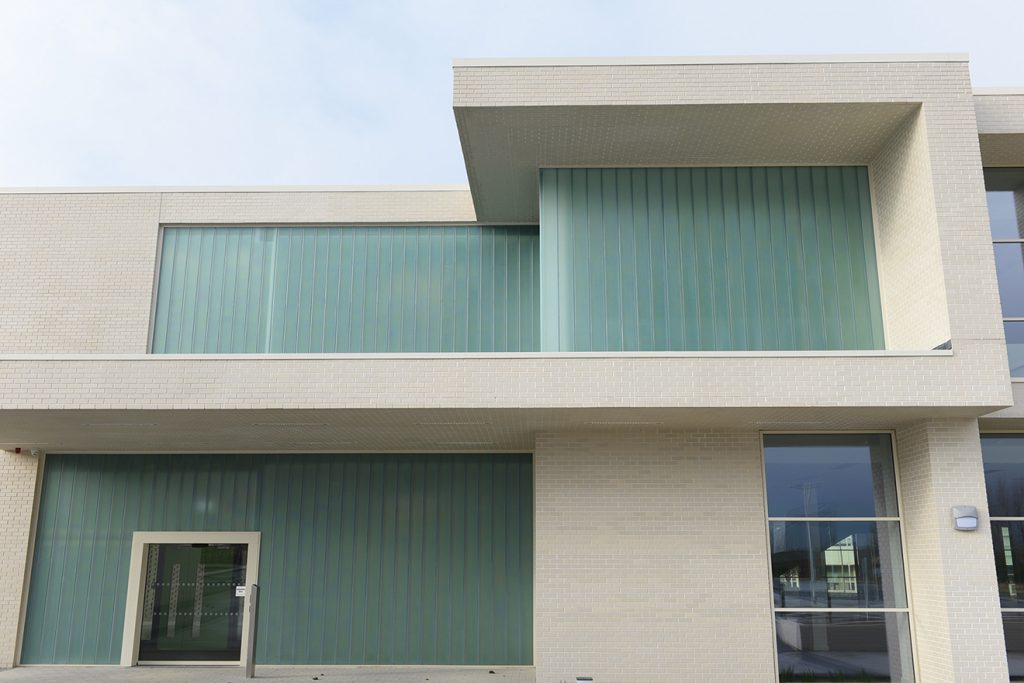
The award-winning Tandragee Roofing Company was the natural choice as a sub-contractor for the new IDA Advance Building in Dundalk.
A member of the National Federation of Roofing Contractors with four decades of practical experience, they employed products from Bauder, an industry leader in flat roof waterproofing systems and energy efficiency. Ideal for ‘green’ roof works, the Bauder system is tough, with a membrane that is particularly resistant to impact and tearing.
“We also used the Bauder single ply membrane [which meets the UK Building Regulations Part B for External Fire Protection] on the balconies,” said David Laverty, Managing Director of Tandragee Roofing Company.
In addition to installation of the roof on this new build at Dundalk’s Finnibair Industrial Estate, Tandragee Roofing Company utilized the extensive external scaffolding constructed by main contractor Felix O’Hare & Co Ltd to fit lourve cladding by specialist Kingspan.
Tandragee Roofing Company, Mullahead Road, Tandragee BT62 2LD
T: +44 (0)28 3884 0576
E: tandrageeroofing@aol.com
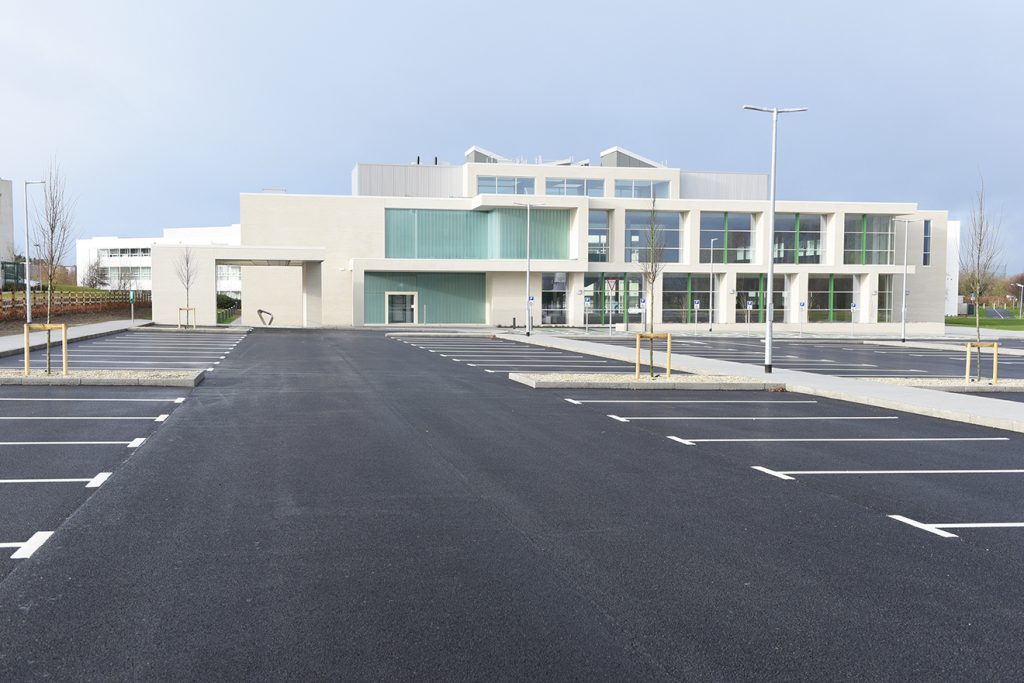
Fittingly for a new build situated in Dundalk’s Sustainable Energy Zone, the shell and core works by Dublin company Phoenix Mechanical Ltd were fundamentally eco-friendly.
Compact and high-powered LPHW [Low Pressure Hot Water] boilers from Remeha’s Quinta Range serve air-handling units and metered provision for each floor of the IDA Advance Building – designed with future fit outs in mind.
“The landlord areas are also served by fan coil units from the LPHW, and that supply and return air ductwork tempered from air-handling units has been run throughout the floor spaces, with metered provision on each floor,” said Phoenix’s Director Gary Brennan. “Chilled water is served by two chillers on the roof.
“Domestic water services are supplied by a cold water storage tank and Grundfos booster pump, as does the greywater. The domestic water also has an LPHW coil, an immersion, and solar panels. The entire system is managed through Cylon intelligent control.”
Phoenix Mechanical Ltd, a relatively young company, can now add the IDA’s Advance Building to an impressive portfolio of work that also includes projects at Trinity College, Dublin, the DCU Alpha Building, and the Environmental Protection Agency.
T: +353 (0) 1 612 0083
E: info@phoenixmechanical.ie
W: www.phoenixmechanical.ie
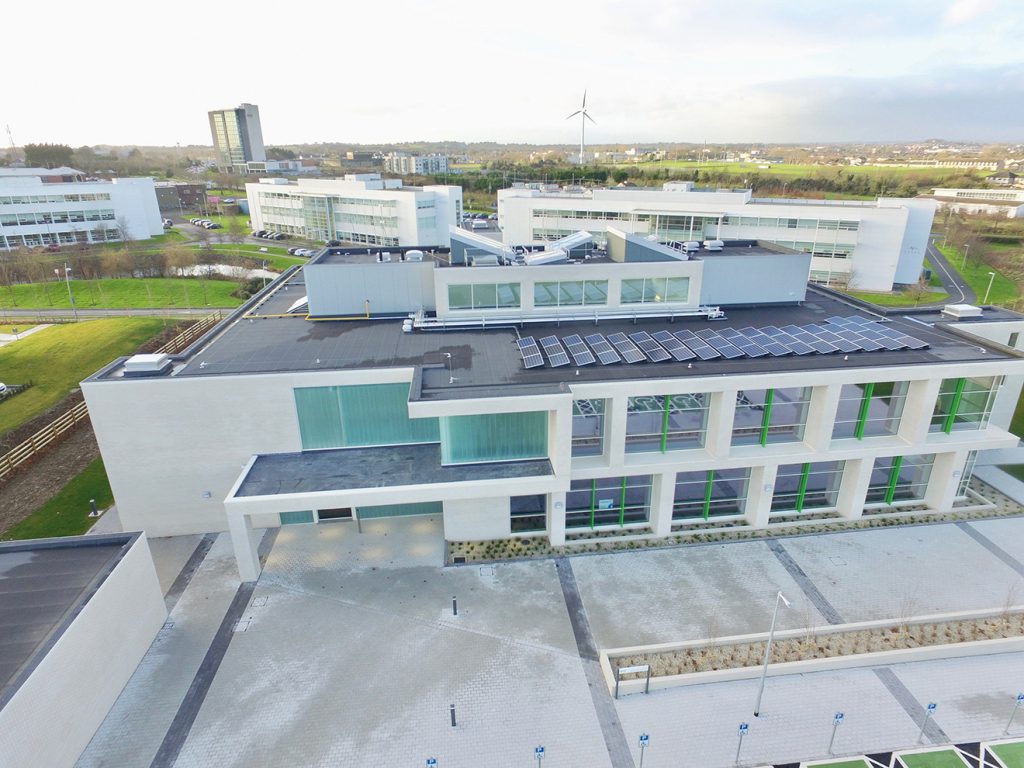
The IDA Ireland’s new €7m Advance Building in Dundalk benefits from a ‘green’ gravity roof drainage system, along with a siphonic drainage system, that is far superior to traditional methods. The siphonic high-velocity drainage system installed by specialists RWP (IRL) Ltd requires fewer outlets and roof penetrations, smaller pipe diameters, and horizontal pipe runs with no drop required.
“At first glance it might appear a relatively simple concept, but there is a lot science behind siphonic drainage,” said RWP (IRL) Ltd’s Managing Director, Alan Turner. “It’s important to be involved in the early stages of the project and sitting down to plan with the design team can save the main contractor a lot of time with underground drainage systems, as siphonic systems use fewer down pipes.”
Designed to work even at the height of a rainstorm, this system differs from the conventional. When the piping is completely charged with rainwater a special baffle that acts as an anti-vortex vane, draws the water, but not air. “The result is that rainwater is syphoned from the roof at high speeds. It also requires less work, fewer materials, reduces costs… and the carbon footprint.”
T: +44 (0) 28 9751 1105
E: at@rwp-irl.com



